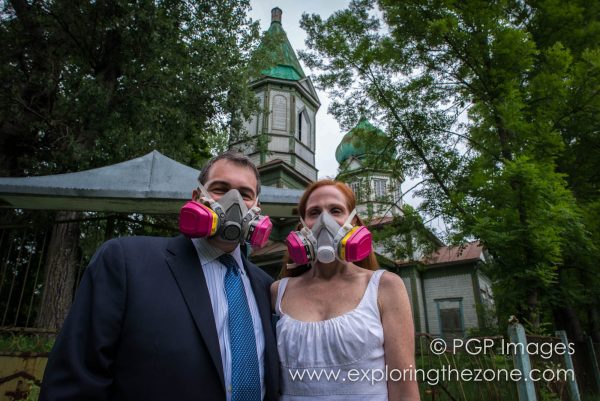Guest post by Philip Grossman:
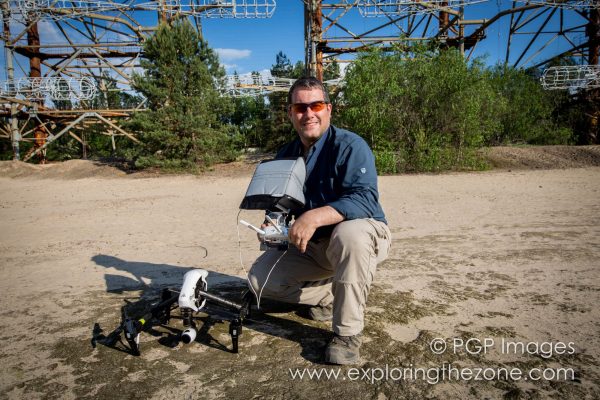
I was the first person to take a drone (my very first, a DJI S-800) into the Chernobyl Nuclear Exclusion Zone nearly four years ago. The idea came after my first expedition in 2011 when I was able to get rare permission for a helicopter flight in the Zone. The helicopter flight was fantastic, but we could not get close enough to the reactor complex and the abandoned city of Pripyat to really get the kind of images I wanted.
So the quest to find a better way to capture images started. I returned to Atlanta and discovered Atlanta Hobby and UAV Experts. Cliff Whitney, president and owner of both operations was fantastic in providing the guidance, knowledge and products necessary to help me make the first drone flight in Chernobyl (and subsequent first drone crash in Chernobyl). Four years later DJI have released their newest professional-level drone, the Inspire 1, and I decided to take one with me to Chernobyl to capture truly unique footage in 4k. The technology and capabilities of this new aircraft make those early drones look like the original Wright brothers’ flyer.
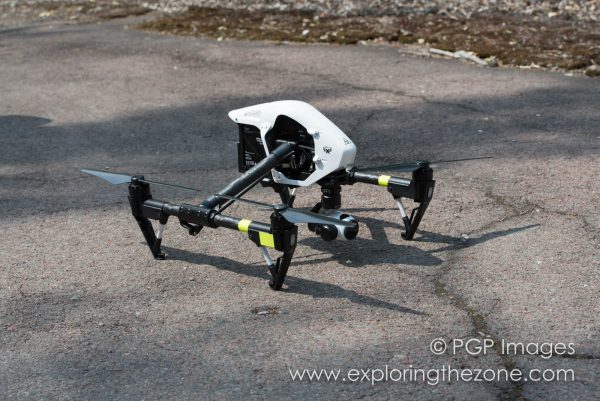
The Inspire 1 system arrives in a soft-sided luggage-style case with the drone, remote (in my case two remotes for dual operation), battery, charger, two sets of props, neck strap for the remote and a bag of spare parts (screws, dampeners, etc). I got four extra batteries and a second charger as I knew I would need them on the trip.
Prior to leaving for Chernobyl I was able to get in about four hours of flights with TJ Diaz from xFlysystems in Colorado (where I now live) and was amazed at how well the Inspire 1 performed. If the Phantom is like a Toyota, then the Inspire 1 is a BMW M3. It is fast (max speed for me was nearing 42 mph) and turns on a dime. Its unique ‘air brake’ system was shocking the first time I experienced it. The quick speed change to the motors enabling near-instantaneous stopping is what required the original pop system to utilize prop locks. I upgraded my system to the new quick release locking props and would recommend annoy who hasn’t done so to also upgrade. The sensitivity of the braking can also be adjusted in the system’s accompanying Pilot app.
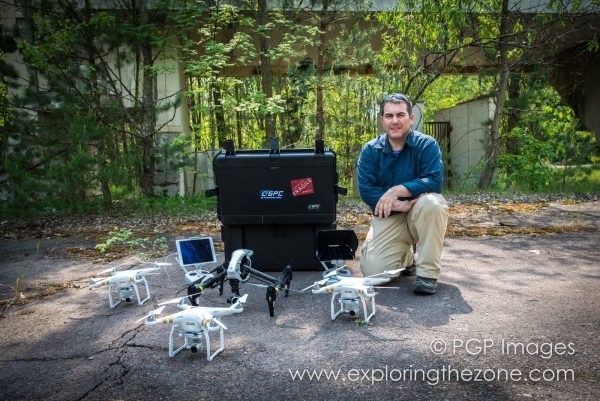
I arrived in Kiev on 25 May. However, my Go Professionals Case (GPC) containing both my Inspire 1 and Phantom 3 did not. After a few stressful hours trying to track down the case, I discovered it had not made it onto my flight (thanks Delta Airlines) but was placed on the next flight out of Atlanta to Amsterdam. It was due to arrive around 2am Kiev local time on 26 May. I trekked back to the Boryspil airport at 2 am to pick up the case, returning to the hotel by 3:30 am in time to get a few hours sleep before departing for the Chernobyl Zone.
RAW uncorrected 4k Video from flying the Inspire 1 over Chernobyl from Philip Grossman on Vimeo.
The first flight in the Zone was at the Stadium Avangard in the center of Pripyat. The flight was planned to climb high enough to actually make out the stadium complex which has become completely overgrown. We started with the ‘calibration dance,’ as we began calling it, in order to ensure compass, Inertial Measurement Unit (The IMU contains the accelerometers and angular rate sensor which measure speed and direction), etc was functioning properly. I think many new drone operators forget that these are technically complex aerial vehicles and needed to be treated as such.
The new DJI Pilot software makes this process simple and straightforward. No more needing to remember which flashing color light means what (though the lights do still flash and change color). The process is as simple as pressing the ‘calibrate compass’ button and following the onscreen directions. The whole process, including validating sensors to make sure they weren’t inadvertently detecting motion (a leading cause of ‘fly-aways’ at take-off), takes less than a minute. The Pilot app provides so much information that getting the Inspire 1 into the air is quick and painless.

The built-in Lightbridge downlink technology, together with the app, makes single-pilot flying a dream. I can see all the data I need, including battery level (in both percentage and time remaining), number of satellites available, heading, vertical speed (rate of climb/descent), ground speed plus all the control information for the camera. All this plus HD video truly makes flying and filming more enjoyable and less stressful.
The Pilot app also provides a map/satellite view in the lower right hand corner that can be enlarged to replace the video downlink view. Though I could see some use for this in non-filming situations, it was not of much value to me. The fact that we had little-to-no cell service in the city of Pripyat meant that the map function was, well, less than functional. It is possible to cache the map prior to flying and I did do this to see how it worked – it just didn’t provide any value for me during this project. The Pilot app does however keep track of all your data and uploads to DJI, where you can access it later and review the details of your flight as well as a map of your course.
After our initial test flight in Chernobyl we moved onto filming in Center City where we have tried each trip to get a shot flying down Lenin Ave from the entrance of the city to the Palace of Culture. In our previous attempts, with both the S-800 and Phantom 2, we had issues with the forest overgrowth: the signal wasn’t able to penetrate the heavy vegetation and we would lose the video downlink (a typical 5.8 Ghz system which does not have a lot of “penetrating” power) and could not align the shot.
We arrived in City Center and I quickly unpacked the Inspire 1 from my GPC case. One of the best features of this case is that the Inspire remains in flight mode with camera/gimbal attached. You simply pull the remotes and Inspire out, install the props and you’re almost ready to fly. I converted my props to the quick release system – I would recommend anyone still flying with the original screw-on prop system to convert as it makes the drone safer to fly and much quicker to set up and tear down.
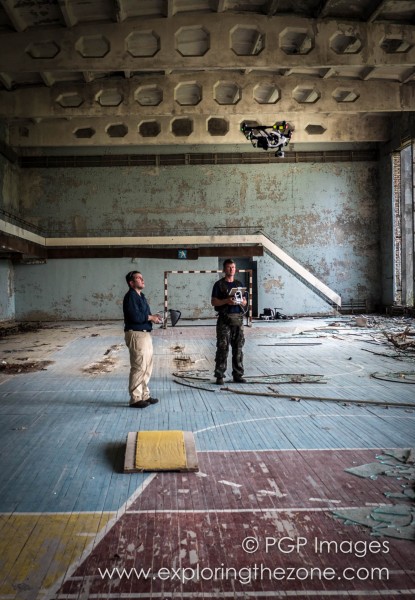
I did the calibration dance again and prepped the Inspire for take-off. During this particular flight my filming partner Arek manned the second controller to man the camera and make sure we got the shot. Even with all the dense forest overgrowth along Lenin Avenue in Pripyat, we were able to get the Inspire to the entrance of the city, nearly 3,000 feet away from our launch position. I turned the aircraft 180 degrees to set up the shot, which was easy thanks to the heading information presented in a small window in the lower left of the Pilot app. I pushed the controls forward enough to gain a steady ground speed of about 7 mph and completed the shot, not only once, but twice on the same battery.
The Inspire 1 has two battery sizes available, the T47 (4500 mAh or 99.9 Wh) and the T48 (5600 mAh or 130 Wh). The T48’s weren’t readily available prior to my trip so I took nine (9) T47 batteries.
The topic of transporting LiPo batteries on commercial flights is confusing at best. I spent hours researching FAA and TSA requirements to make sure I knew the rules. The short of it is you can theoretically carry unlimited LiPos in the passenger cabin as long as they are below 100 watt hour (https://goo.gl/qmUBwb) and can carry on two (2) batteries between 100 and160 watt hour. You may not place the batteries in the luggage compartment unless they are installed in the aircraft.
I placed all nine (9) of my Inspire 1 batteries as well as four Phantom 3 batteries in a Pelican 1450 case, placed ‘Discharged’ stickers across the LED and power buttons and placed electrical tape across the contacts. I passed through a total of five airport security checkpoints as I carried them onto and off the plane on this trip and not once did I have any questions about the batteries.
With the T47 batteries installed I was getting a total flight time close to 18 minutes, though I would rarely fly below 30% to ensure flight safety – LiPo batteries have a very sharp fall off at the end of their energy curve. I can tell you that a 15-minute flight is typically more than enough to capture what you need. If you need to fly the shot multiple times, just use multiple batteries.

On the seventh day of the expedition I pushed the Inspire’s range and endurance capabilities. We drove into the approximate middle of the abandoned city of Pripyat and climbed to the top of the 16-storey apartment structure at 12 Heroiv Stalinhradu street. I did the calibration dance on the roof of the building and launched the Inspire 1. I immediately flew south west until I crossed well over the city border and lost video connection. One of the nice aspects of the pilot app is you get a warning that the video downlink signal is poor before it completely drops out.
At that point I turned the craft 180 degrees and began flying east across the abandoned city as far as the Inspire’s Lightbridge system would allow. I made it well beyond the eastern border of the city and broke the 1.5km no-fly zone around the Chernobyl Nuclear Power Plant as dictated by our permits. I flew as close as I felt comfortable as I did not want to be held up at gunpoint (again) by the Ukrainian SBU (equivalent to the US CIA/FBI). The distance on the pilot app read nearly 5,000 feet. I then returned the aircraft to our location and flew nearby as I still had around 40% battery life left. After landing, I swapped batteries and we did the flight again. The maximum total flight distance on the second flight was 18,500 feet (slightly more than three miles).
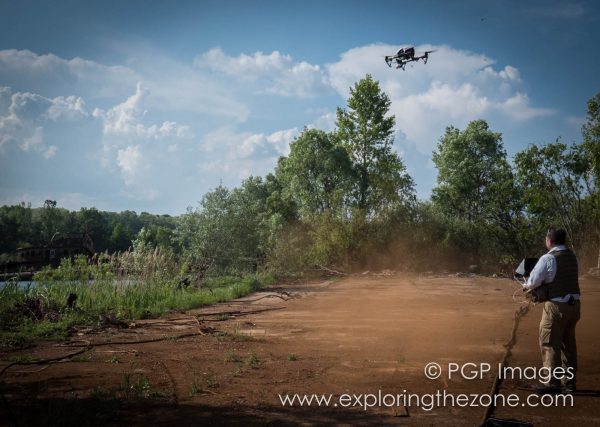
Having come through the era of build-your-own drones, the build quality and performance of the Inspire 1 exceeded my every expectation. DJI’s manufacturing capabilities have really improved during the four years or so that I have been flying drones. The unique landing gear system is solid and worked without issue, allowing the arms/motors to raise above the craft: they clear the camera/gimbal system to allow a full 360-degree view.
The 4k camera system was also very impressive for an all-in-one solution. Its rectilinear lens sets it apart from the GoPro and allows my post production workflow to remove the render-hungry step of lens correction. The integrated remote and Pilot app allowed me to quickly switch between filming and taking photos. I could stop and start the filming at any point not wasting precious storage on the micro SD card as I transitioned from takeoff to filming location. The camera has a LOG profile as well enabling the footage to more easily match shots from my Sony FS7. You can shoot fully automated or fully manual, opening up a world of creativity.
The Inspire platform (I really think that is the best way to describe it) is not without some areas I would like to see improved. After all nothing is perfect, though from a flying perspective I think the Inspire is really close. I might have some unique flying requirements for distance since there are some areas I am unable to get close to in Chernobyl, so I would like to see an option for increased range on the transmitter without requiring me to hack it with one of several kits I have seen popping up on the internet. Those sort of defeat the clean, integrated platform design.

The main area I think could use some modifications or upgrades primarily relate to the camera. The footage is pretty amazing for its size. However, I would like to an increase in frame rate to 4k60p. Though being able to record hours on a 64 GB microSD card is great, I would exchange that record time for a higher bit rate and color depth. Most of my current cameras shoot 4:2:2/10 bit – this makes a huge difference to the capture of color data, the post production workflow and eventually to the end product.
The current camera is limited to 60Mbps and is most likely 4:2:0/8 bit. Increasing the frame rate and color information capture would provide a lot of flexibility and could make me think twice about the cost and risks of flying a RED/Arri/Sony on a very large drone. I would like to see a larger sensor as well, which would improve the low light capabilities. Though not bad, you do start to see chromatic noise in low light conditions. We shot an early morning sunrise which ended up being more overcast than golden hour and there is some noise in the image.
I have read in various forums about wanting different focal length lenses for the camera and I could see some benefit from that in my work. The current lens is listed as 20mm (35mm equivalent) which provides amazingly wide shots with almost no distortion. The addition of a 35mm or 50mm could again provoke more second thoughts about launching a cinema camera and heavy lift vehicle in a lot of situations.
Behind the scenes of shooting in Chernobyl with a DJI Inspire 1 from Philip Grossman on Vimeo.
In summary, the DJI Inspire 1 really is the BMW M3 of drones. It’s quick and agile, small enough to fly indoors and tight spaces and with enough endurance to cover three to four miles in a flight. It reaches its maximum altitude (1,500 ft) in less than two minutes. The footage from the camera is simply stunning and amazingly stable. The airframe has several mounting areas that currently aren’t being used by anything and the remote has a CAN Bus port, so I am looking forward to some exciting new accessories. Maybe a Lightbridge range extender or 4k 60p RAW 422/10 Bit M4/3 Camera with two or three interchangeable lenses? I think this is going to be a very expensive year for me.
About the author:
Philip Grossman is the Director of Global Solutions Architecture for Imagine Communications, a global leader in video infrastructure, advertising systems and workflow management solutions serving the media networks, broadcast stations, digital media, communication service provider and enterprise markets spanning 185 countries.
He is also an independent film maker and cinematographer based in Denver, Colorado and has been working on a five-year personal project documenting the Chernobyl Nuclear Exclusion Zone. Philip is a self-professed geek when it comes to film production equipment and has been involved in the art and science of film-making for over 20 years. Most recently he got married to his wife Elizabeth Hanson (@lizwhanson) in the Chernobyl Exclusion Zone.
Philips websites are www.pgpimages.com and www.exploringthezone.com and you can contact him on [email protected]
